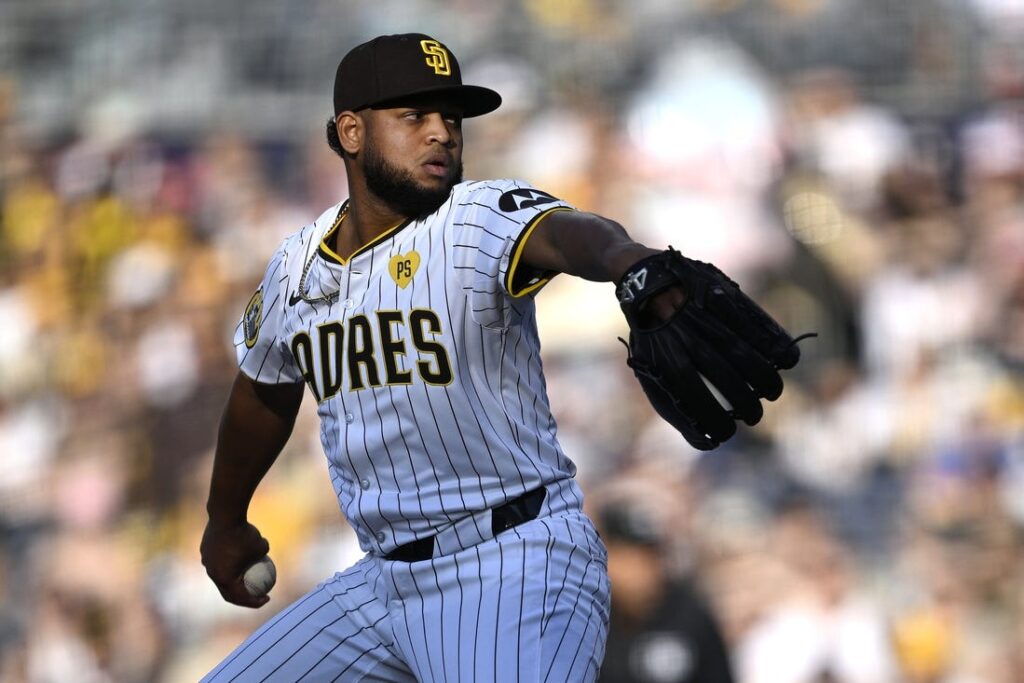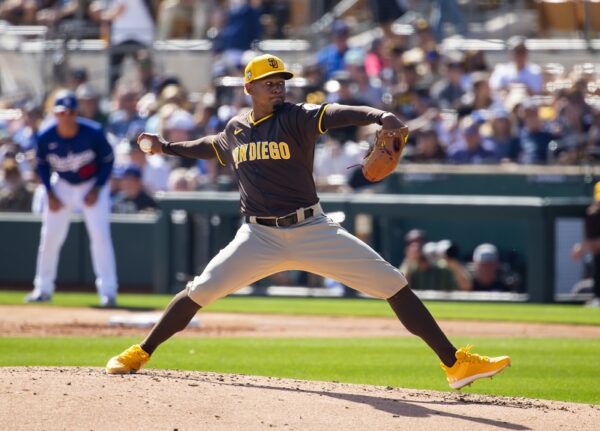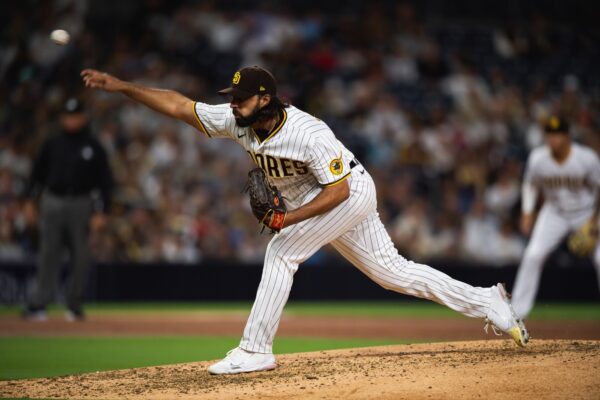Analyzing the Padres rotation options moving forward

Getty Images

Before Thursday’s game against the Mets, the San Diego Padres optioned right-hander Matt Waldron.
Waldron has been a constant in the Padres’ rotation, making 26 starts this season. However, the right-hander has struggled significantly lately, posting an 8.00 ERA in his last seven starts.
After his optioning, the team faces a challenge, as they have an upcoming gauntlet of 16 games in 17 days. With the team needing a fifth starter for at least two starts, let’s examine a few internal options between players on the 40-man roster and players not yet on the 40-man.
Before we begin, a pair of disclaimers:
1. I will not be including right-hander Yu Darvish in this article, as he is an option, but there is no timetable for his return. While he was reinstated from the restricted list on August 23, Darvish is still some time away from returning, as he has yet to stretch out into game form.
2. When describing “the case against” any of these players, it is not a knock on the player’s ability, performance, etc. It is merely a statistical analysis of potential factors the Padres organization may consider as a rationale to justify a promotion (or lack thereof). There is a reason these players are making money to pitch in professional games, and I am not.
With that being said, let the analysis begin.
Options on the 40-Man
RHP Jhony Brito
The case for Brito:
Jhony Brito was acquired in the Juan Soto trade in order to provide the Padres with starting pitching depth that was under long-term team control. Despite his use as a reliever at the major league level this season, Brito’s advanced numbers paint a better picture of his performance. Across 43.2 innings of relief, Brito has posted a 3.99 expected ERA, and his changeup and four-seam fastball have held batters to .231 and .211 batting averages, respectively. His sweeper has a massive disparity between its batting average against and expected batting average (xBA), so the changeup-fastball-sweeper trio could help Brito make it through a lineup twice, which could be just what the Padres need with the acquisition of Bryan Hoeing.
The case against Brito:
Despite the results in relief, Jhony Brito has not pitched more than three innings in a game in all but two of his outings. The last time Brito tossed more than three innings came back on July 11, when he tossed five shutout innings against the Oklahoma City Baseball Club. After that outing, a game in which Brito threw 36% sliders, Brito’s arm did not bounce back as expected, and he did not make an in-game appearance for 20 days. In his three starts with El Paso since then, Brito has struggled with his command mightily, posting an 11.20 ERA in three starts, which have only spanned a total of four innings. Four. Two of those three starts saw Brito unable to make it out of the first inning. His lone scoreless outing since then was his last big league outing, 2.1 scoreless innings of long relief against the Marlins on August 10. With the Padres facing a long stretch of games, Brito only going three innings would heavily tax the bullpen, potentially leaving the team vulnerable in subsequent games. (Update: Jhony Brito was placed on the minor league injured list on August 23, so he will be ineligible to be recalled until activated.)
RHP Randy Vasquez
The case for Vasquez:
Vasquez has been the Padres’ presumptive sixth starter all season, making a total of 17 starts in place of Yu Darvish and Joe Musgrove. The Padres clearly like what they’ve seen out of Vasquez, as he has been recalled and optioned twice this season, with each recall being after an injury to a Padres starter. Vasquez has shown an ability to be a solid big league starter, as when looking at his last six big league starts, he has posted a 2.57 if his clunker against the Orioles (2 IP, 6 ER) is omitted. Vasquez’s breaking pitches have also been effective this season, as his curveball (.220 BAA), cutter (.209 BAA), and sweeper (.222 BAA) have given hitters fits this season.
The case against Vasquez:
While Vasquez has made 17 starts at the big league level, six of those have seen the right-hander allow over four runs. If there has been one major shortcoming in Vasquez’s performance, it is his inability to retire batters in two-strike counts. Opposing batters are teeing off on Vasquez when he is behind in the count, batting .409 against him in those scenarios. Furthermore, Vasquez has struggled to generate whiffs at the major league level. A 19.1 whiff rate might not sound too bad, but it ranks in the bottom 8% of all major league pitchers. Vasquez’s low whiff rate partially ties into his 14.9% strikeout rate, which ranks in the bottom 4%. The Padres will want quality innings from whomever they call up, and a 12.20 ERA in two starts since being optioned on August 9 may not be the best look for Vasquez.
RHP Sean Reynolds
The case for Reynolds:
The biggest wild card of players on the 40-man, Sean Reynolds, made three starts for the Chihuahuas earlier this season. Batters at the major league level have struggled against Reynolds and his blistering fastball. His slider has been even better, as batters are hitting .167 with a .110 xBA against the pitch. Reynolds last pitched on August 20 against Minnesota, coming on in relief of Matt Waldron and tossing 2.2 innings of scoreless relief, striking out four. If the Padres want Reynolds to start in Waldron’s spot, he is already lining up to be on a full starter’s rest schedule for the next time that spot in the rotation is scheduled to pitch. (Update: Reynolds tossed a scoreless ninth inning on August 24 vs the Mets, so he is likely to continue pitching in relief)
The case against Reynolds:
Sean Reynolds has not started a baseball game since June 28. Since then, Reynolds has appeared in 14 games between Triple-A and the majors, and his longest of those outings was the aforementioned 2.2 innings. Even when he started games, Reynolds has yet to pitch more than 3.2 innings in a game this season. In that 3.2 inning outing (July 6 vs Albuquerque), Reynolds tossed only 50 pitches, a far cry from a starter’s expected pitch count. The Padres have had starters on pitch counts this season, but at this point in the season, with nine games remaining before rosters expand, the Padres may not be able to afford such a tight leash on a pitcher.
RHP Bryan Hoeing
The case for Hoeing:

Bryan Hoeing was acquired to be a Swiss army knife on this team’s pitching staff, much like 2022 Nick Martinez. Hoeing has started two games this season (out of 24 appearances) and has 14 multi-inning outings as well. Furthermore, Hoeing was called upon to replace Dylan Cease after a questionably-timed rain delay August 6 against Pittsburgh, tossing 3.2 innings of long relief. Hoeing has also shown an ability to be effective in keeping his pitch counts low, as his splitter has helped him escape jams with timely ground ball outs.
The case against Hoeing:
Bryan Hoeing has not started a game since July 10 vs Houston. The right-hander has tossed long relief since then, but the Padres have turned to him whenever a starter has exited a game before the fifth inning and when they need a ground ball double play. Hoeing has made seven appearances in August, the last three of which have all come with one day’s rest in between. It appears as though Bryan Hoeing has made a role for himself in the Padres’ bullpen, and his outing on August 23 leaves him off schedule for the next start that would have been in Matt Waldron’s spot in the rotation.
Options Not on 40-Man
LHP Omar Cruz
The case for Cruz:
The Padres have only received four starts from left-handed pitchers this season, all four coming from Martin Perez. Adding a second left-hander to the rotation (if only for a start or two) would allow the Padres to change the opposing team’s approaches towards the team. The next two opponents for the fifth spot in the rotation are the St. Louis Cardinals and Tampa Bay Rays, two teams who have strong left-handed batters in the middle of their lineups. Cruz’s performance in his starts this season has also deemed him worthy of a call-up, as in his last five outings (two starts and three long relief outings), he has put up a 2.25 ERA in 24 innings, striking out 30 and walking only six in that span. Cruz also generated whiffs on 46% of swings against him in his last appearance (3.2 IP), so his swing-and-miss stuff could be just what the rotation needs. Even if it is only for one or two starts, Cruz getting a cup of coffee at the big league level could allow him to be placed on the 40-man roster before the end of the season, as he is Rule 5 eligible.
The case against Cruz:
The Padres don’t really have too many 40-man roster spots to go around, currently standing at a full 40-man and only three players on the 10-day and 15-day injured lists. Two of those players, Ha-Seong Kim and Wandy Peralta, are expected to return in September. The only candidate to go on the 60-day IL is right-hander Stephen Kolek. Furthermore, there are not many optionable players on the active roster, with the only pitchers likely to be optioned are right-handers Logan Gillaspie and Sean Reynolds, and Reynolds is looking like a more unlikely candidate. Cruz’s three-pitch mix is solid, with varying speeds, but it’s still a three-pitch mix. No matter how solid the offerings are, the Padres may find themselves unwilling to allow him to see an order more than twice through.
RHP Carl Edwards Jr.
The case for Edwards:
The Padres signed (and re-signed) Edwards as a starting pitcher, and the right-hander has posted a serviceable 4.76 ERA in the pitcher’s nightmare known as the PCL. His underlying peripherals paint a slightly better picture, as Edwards has struck out 23.7% of opposing hitters in his starts. Edwards has also made it to the high-80s and low-90s in terms of pitch count this season, so he would not really face too much of a pitch limit.
The case against Edwards:
Despite the impressive strikeout numbers, Edwards has always had one major flaw in his game: his command. Edwards has walked 15.8% of batters in his time in El Paso. Edwards’ command was also apparent in his lone major league appearance, as he walked two and allowed a single before being pulled. Edwards’ three-pitch mix is also more conducive to relief work as opposed to starting duty, as was seen in his initial call-up.
RHP Nabil Crismatt
The case for Crismatt:

Right-hander and Padre fan favorite Nabil Crismatt has returned to the organization as a starting pitcher. Crismatt has made eight starts for the Chihuahuas this season and has gone at least four innings in four of his last five starts. Unlike Cruz and Edwards, Crismatt has a deeper arsenal, with five pitches he can turn to. Crismatt also has experience with the Padres at the major league level, as he pitched in 102 games with San Diego between 2021-23, with the last two of those years under current pitching coach Ruben Niebla. Crismatt has also pitched in tight playoff races before, between the 2021 collapse and 2022 season, so he has experience under the type of pressure the Padres face over the coming month.
The case against Crismatt:
While Crismatt has started eight of nine appearances since July 1, his last two starts have seen opponents score 13 runs in six innings (19.50 ERA). These struggles are in a small sample size, as in his prior five starts, Crismatt had a 3.42 ERA and 18 strikeouts to seven walks in 21 innings. Crismatt has shown good command in his career but doesn’t throw particularly hard, as his fastball sits in the 88-91 mph range. Crismatt is also another arm who could profile better in long relief, like Edwards. In all but one of his previous 102 appearances as a Padre, Crismatt came out of the bullpen, making his lone major league start on April 4, 2022, in lieu of an injured Blake Snell. Given his prior use in the Padres organization, it is possible he is viewed more as a long reliever than a starter.
RHP Jared Kollar
The case for Kollar:
One of the best stories in the Minors for the Padres this season has been the emergence of right-hander Jared Kollar. Kollar has pitched at both Double-A and Triple-A this season, posting a cumulative 3.65 ERA in 106 innings. The right-hander has posted consistent innings and command this season, striking out 21.1% of batters and walking 6%. Of the four non-roster pitchers discussed, Kollar has the lowest walk rate. Despite lower strikeout rates, Kolalr has succeeded by generating soft contact and ground balls, a skill that would play with the Padres’ strong defensive infield. Kollar also relies on a four-pitch mix that has the ability to move north-south and east-west, and while his velocity isn’t blistering, his over-the-top delivery could give batters trouble.
The case against Kollar:
While Kollar has posted a successful season thus far, he has only made five starts at Triple-A this season. Granted, the Padres did promote Adam Mazur after four starts at Triple-A, only to see the right-hander post an ERA of 7.49 (6.22 FIP). While Kollar has fared better at Triple-A than Mazur, it is possible that it is too soon for him to be promoted. Kollar also lacks a traditional east-west pitch, as his main secondaries are a curveball and changeup. Kollar has leaned on a cutter this season to increase his ground ball production, and his command certainly helps with that pitch, but it is a pitch he needs to be very precise with to avoid it getting hit hard.
The San Diego Padres certainly have a plethora of internal options to bolster their starting staff while they wait for Yu Darvish to return and while they give Matt Waldron a “reset” period. The question, when all is said and done, is now a matter of “who.”
A born and raised San Diegan, Diego Garcia is a lifetime Padres fan and self-proclaimed baseball nerd. Diego wrote about baseball on his own site between 2021-22 before joining the East Village Times team in 2024. He also posts baseball content on his YouTube channel “Stat Nerd Baseball”, creating content around trades, hypotheticals, player analyses, the San Diego Padres, and MLB as a whole.
A 2024 graduate of San Diego State, Diego aims to grow as a writer and content creator in the baseball community.